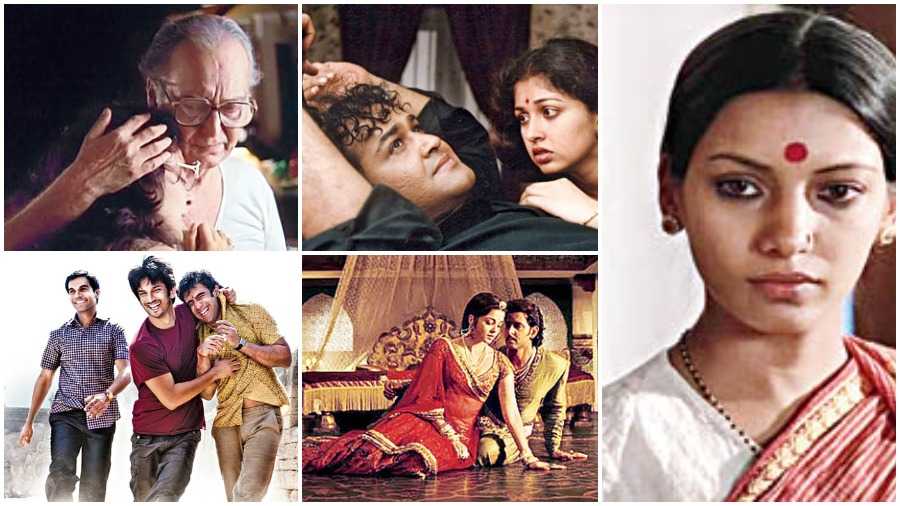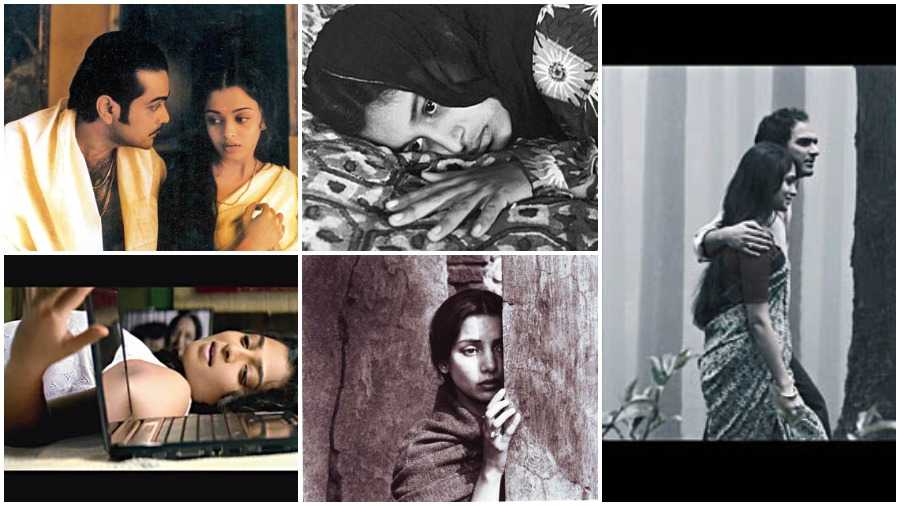Chokher Bali
In Rituparno Ghosh’s meticulously structured adaptation of the eponymous Rabindranath Tagore novel, light plays a crucial role in positioning Binodini’s (Aishwarya Rai) rebellion against a male-dominated society. Primarily shot indoors, cinematographer Avik Mukhopadhyay’s use of natural light is critical in rendering the plight of a lonely young window whose resilience powers her. One exquisite sequence has her laughing hysterically at Mahendra’s (played by Prosenjit) pursuit, swathed in white. It is as if her beauty is emanating from within, under all the restlessness and boundations. In its sensual exposition of passion and power dynamics, Chokher Bali is an evocative, ephemeral work.
Uski roti
Cinematographer K.K. Mahajan’s celebrated work in Mani Kaul’s distinctive directorial feature follows the tale of truck driver Sucha Singh and his wife Balo. It is Balo’s public and private self that finds expression in two different camera lenses, often in long sequences without following a particular order. The viewer is left with the pieces to assemble themselves, even as Kaul and Mahajan strip movement away in scenes, distilling a pure, uninitiated look. Watch out for the sequence when Balo slowly fades away in the background, inhabiting space and time above the wavelengths of the narrative framework.
Asha Jaoar Majhe
Aditya Vikram Sengupta’s debut directorial features an astounding interplay of sights and sounds that fill the lives of a middle-class Bengali couple, staying apart to make ends meet. Bereft of any dialogue, Sengupta who also took on the role of the film’s cinematographer along with Mahendra J. Shetty, lets his audience into the synchronised world of these two people (played by Ritwick Chakraborty and Basabdatta Chatterjee) with careful abandon. The dream sequence in particular, is stunningly shot, almost mystical in its understated elegance.
Antaheen
Gorgeously shot, Aniruddha Roy Chowdhury’s tale of discovery and development of identity in a rapidly changing city finds visual poetry in its urban decadence. Particularly significant is the way Avik Mukhopadhyay’s camera lingers on the glass panes, trees and leaves in the song Jao pakhi bolo, where the play of light and colour captures the remnants of natural beauty in a space where our lives have become inseparable from digitalisation.
Khandhar
In this Mrinal Sen film, Shabana Azmi is Jamini, who looks after her bedridden mother in an old, decaying mansion. A chance visit from three city dwellers gives rise to mistaken identities that forms the crux of this atmospheric, understated gem. In one sequence, torch light is used to view the dilapidated condition of the house at night. Jamini’s room is poorly lit too, and the introduction of the three fellows await like an elliptical promise. Sen uses light to uncover the questions of time and significance, modernity and age.... So even if the ray of light falls on Jamini — through a torch or a camera — he suggests that this lasts only for a while. The ruins will still remain.

Asukh
In this father-daughter relationship drama, Rituparno Ghosh masterfully constructs the multiple lives Rohini (Debashree Roy) lives under the same roof with her father Sudhamoy (a brilliant Soumitra Chatterjee) — dutiful daughter, relentless lover and film star. Working with his favourite DoP Avik Mukhopadhyay, Ghosh lights Rohini’s room in a deep, dark blue, reflecting the state of dilemma she’s in, with respect to her position in the matter of things. Rohini’s mind is clouded with anxiety and horror, as she begins to find traces of disloyalty in her parents’ relationship. An unforgettable sequence involving a power cut is where Sudhamoy brings the candle to Rohini’s rescue — at a point when she metaphorically unties herself from the dark, forbidden thoughts about her father. Ghosh uses a Tagore poem, Chotto amar meye, to bring on this catharsis.
Iruvar
Santosh Sivan’s camerawork lends this Mani Ratnam political drama a feverish, pulsating depth. Constantly trying to find different compositions within a frame, Sivan’s lens is almost never static. It has an overarching restraint in every scene — from lighting close-ups of two faces at once, which is normally provided to one face alone, to overarching shots that cover an entire landscape. Particularly unforgettable is the use of light and intensity in the speech delivery sequences... where on one hand there is the subjective passion of the speaker, and then the camera takes one out again towards the objective reality of the applauding audience.
Nishant
In Shyam Benegal’s Nishant, Sushila (Shabana Azmi) is abducted by the zamindar’s sons, after which the whole village steadily assimilates to stand up for the corrupt and immoral feudal system. Nishant, which means ‘night’s end’, gradually unravels from darkness to light, baring uncomfortable truths about the consequences of power and authority. Taking place primarily during the nocturnal hours, Nishant — shot by film-maker Govind Nihalani — slowly builds up to its culminating act in daylight, with or without reconciliation. The pattern is laid open by Benegal for his viewers to discern.
Jodhaa Akbar
Brimming with fabulous set design and costumes that make historical characters come alive on screen, Jodhaa Akbar is a film for the ages. The use of light here in depicting the love story between a Mughal emperor and a Rajput princess becomes a marker of their understanding of each other, thus developing a bond filled with respect and love. The one scene etched in memory arrives midway through in In Lamhon ke daaman mein where the bright rays during sunset light up the inner chamber through the reflection in the mirrors, illuminating the room in a golden hue. Pure cinematic beauty!
Kai Po Che!
The shot of three friends Ishan, Omi and Govind running from darkness to light in the spirited tunes of Manjha is still as fresh now as it was when this Abhishek Kapoor directorial released eight years ago. Then there is also the bright and beautiful garba number in Shubhaarambh, where the two lovers consummate their love for one another. In Anay Goswamy’s vivid shots of the rustic hinterland, the use of colour and light compensates for life swinging through youthful enthusiasm, whereas a light sepia tone used in the background hooks them back into the realities of power and authority.
